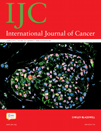Roles of galectin-7 and S100A9 in cervical squamous carcinoma: Clinicopathological and in vitro evidence
Abstract
In our study, we for the first time assessed the association of galectin-7 and S100A9 with clinicopathological variables and survival outcomes in cervical squamous carcinoma patients and explored the underlying molecular mechanisms in cervical squamous carcinoma cell lines. Immunohistochemical analysis of 243 patient samples showed that the positive staining rate for galectin-7 and S100A9 gradually decreased from normal cervical tissue to intraepithelial neoplasia and to cervical squamous carcinoma. Both galectin-7 and S100A9 showed significant negative association with lymph node metastasis and staging of cervical squamous carcinoma. Cervical squamous carcinoma patients with negative staining of galectin-7 or S100A9 showed significantly lower 5-year overall survival rate than those with positive staining. Multivariate analysis with the Cox's proportional hazards model indicated that both galectin-7 and S100A9 had significant protective effect on cervical squamous carcinoma patients. Subsequent in vitro study in SiHa and C-33A human cervical squamous carcinoma cell lines revealed that knocking down galectin-7 or S100A9 enhanced tumor cell invasion and tumor cell viability against paclitaxel-induced apoptotic stress, likely through increasing the matrix metalloproteinase-9 expression and activating the phosphatidylinositol 3-kinase/Akt signaling pathway, respectively. Knocking down both galectin-7 and S100A9 produced a synergistic effect, with galectin-7 displaying more significant and consistent protective effects than S100A9 on cervical squamous carcinoma cells. In summary, our study for the first time provides clinicopathological and in vitro evidence showing that both galectin-7 and S100A9 play important protective roles in cervical squamous carcinoma, which provides fresh insights into the biology of cervical squamous carcinoma.
Abstract
What's new?
The proteins galectin and S100A9 both influence the progression of cervical cancer. Earlier investigation revealed that the two proteins make chemotherapy and radiation therapy more effective. In the current report, the authors showed that as cells progressed from normal to cancerous, they contained less galectin and S100A9. Furthermore, analysis of patient samples revealed that galectin, and to a lesser extent S100A9, improved 5-year survival rates.




